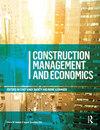Implementing relational contracting in a public client organization: the influence of policy clashes, resources and project autonomy
IF 3.3
Q2 BUSINESS
引用次数: 1
Abstract
Abstract Relational contracting models are increasingly being used for large and complex public infrastructure construction projects, but both practices and outcomes still widely vary. When analyzing the causes of failures and successes, most studies have focused on practices at the project level. In this paper, we add to the current understanding of relational contracting in public construction by examining the influence of factors at the organizational and institutional levels. We develop a framework based on theories of policy implementation and analyze two projects piloting a new Early Contractor Involvement model in a large public infrastructure client organization. In this case, a previous marketization policy, prescribing low client involvement in project processes, interfered with the relational contracting policy. This policy clash was not openly acknowledged from the start, despite causing significant confusion and frustration at the project level, but became recognizable largely through its consequences for resource allocation and managerial attention. We conclude that policy ambiguities, combined with a project-based implementation context, produce local interpretations and variations in relational contracting models. When project autonomy is high, industry-level agreements, standards and resources are important to align practices also between projects within the same client organization.公共客户组织实施关系契约:政策冲突、资源和项目自治的影响
关系承包模式越来越多地应用于大型复杂的公共基础设施建设项目,但实践和结果仍然存在很大差异。在分析失败和成功的原因时,大多数研究都集中在项目层面的实践上。在本文中,我们通过考察组织和制度层面因素的影响,增加了对公共建设中关系承包的现有理解。我们开发了一个基于政策实施理论的框架,并分析了在大型公共基础设施客户组织中试行新的早期承包商参与模式的两个项目。在这种情况下,先前的市场化政策规定客户在项目过程中的参与度较低,这干扰了关系承包政策。这种政策冲突从一开始就没有得到公开承认,尽管在项目层面上造成了重大的混乱和挫折,但通过其对资源分配和管理注意力的影响,这种冲突在很大程度上得到了承认。我们的结论是,政策的模糊性与基于项目的实施环境相结合,在关系契约模型中产生了当地的解释和变化。当项目自治程度较高时,行业级协议、标准和资源对于在同一客户组织内的项目之间对齐实践也很重要。
本文章由计算机程序翻译,如有差异,请以英文原文为准。
求助全文
约1分钟内获得全文
求助全文
来源期刊

Construction Management and Economics
BUSINESS-
CiteScore
7.50
自引率
14.70%
发文量
58
期刊介绍:
Construction Management and Economics publishes high-quality original research concerning the management and economics of activity in the construction industry. Our concern is the production of the built environment. We seek to extend the concept of construction beyond on-site production to include a wide range of value-adding activities and involving coalitions of multiple actors, including clients and users, that evolve over time. We embrace the entire range of construction services provided by the architecture/engineering/construction sector, including design, procurement and through-life management. We welcome papers that demonstrate how the range of diverse academic and professional disciplines enable robust and novel theoretical, methodological and/or empirical insights into the world of construction. Ultimately, our aim is to inform and advance academic debates in the various disciplines that converge on the construction sector as a topic of research. While we expect papers to have strong theoretical positioning, we also seek contributions that offer critical, reflexive accounts on practice. Construction Management & Economics now publishes the following article types: -Research Papers -Notes - offering a comment on a previously published paper or report a new idea, empirical finding or approach. -Book Reviews -Letters - terse, scholarly comments on any aspect of interest to our readership. Commentaries -Obituaries - welcome in relation to significant figures in our field.
 求助内容:
求助内容: 应助结果提醒方式:
应助结果提醒方式:


